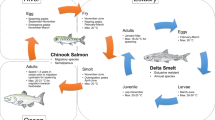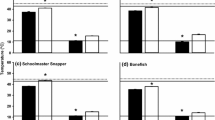Abstract
In California’s Sacramento-San Joaquin estuary, environmental protection and habitat restoration efforts directed at a threatened native osmerid, the delta smelt (Hypomesus transpacificus), are complicated by the presence of a morphologically similar non-native congener, the wakasagi (H. nipponensis), transported to the estuary from upstream reservoirs. In order to better define delta smelt critical habitat and to evaluate the potential for habitat overlap by these two species, we compared the tolerances of the two species to temperature, salinity, and water velocity, environmental factors that vary spatially and temporally within the estuary. For fishes acclimated to 17°C and fresh water (0 ppt), we measured critical thermal maxima and minima, chronic upper salinity tolerance limits, and critical swimming velocities. Wakasagi had higher critical thermal maxima (29.1°C vs. 25.4°C for delta smelt), lower critical thermal minima (2.3°C vs. 7.5°C for delta smelt), higher upper salinity tolerances (26.8 ppt vs. 19.1 ppt for delta smelt), and swam faster (for 6–6.9 cm SL fish, 43.3 cm s–1 vs. 28.2 cm s–1 for delta smelt) than delta smelt. This suggests that the wide seasonal and year-to-year fluctuations in temperature, salinity, and flow typical in the estuary would not exclude wakasagi, although their eggs and larvae may be less tolerant. With respect to these factors, the native delta smelt may be at a physiological disadvantage, particularly in habitats with suboptimal environmental conditions, and may be excluded from shallow-water habitat restoration sites, which are characterized by poor circulation, low flows, and more environmentally extreme conditions. The low abundance of wakasagi in the estuary recorded to date may indicate that factors other than temperature, salinity, and flow determine wakasagi distribution.
Similar content being viewed by others
Author information
Authors and Affiliations
Additional information
Received: 25 August 1999 / Accepted: 22 November 1999
Rights and permissions
About this article
Cite this article
Swanson, C., Reid, T., Young, P. et al. Comparative environmental tolerances of threatened delta smelt (Hypomesus transpacificus) and introduced wakasagi (H. nipponensis) in an altered California estuary. Oecologia 123, 384–390 (2000). https://doi.org/10.1007/s004420051025
Issue Date:
DOI: https://doi.org/10.1007/s004420051025




